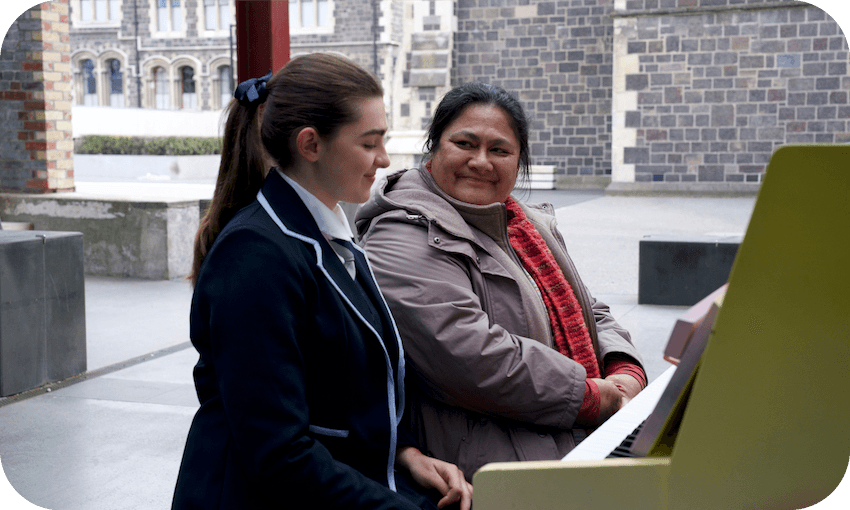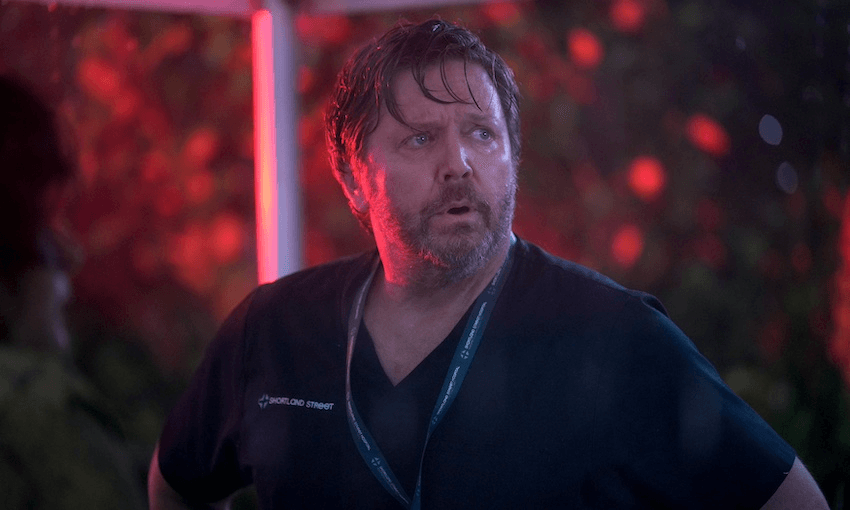Alex Casey talks to Tinā writer and director Miki Magasiva about setting the film in Ōtautahi, and what he learned from the community.
The first of many palpable moments in the room at the Christchurch premiere of Tinā came during a phone conversation between the main character Mareta (Anapela Polataivao) and her daughter. She’s seeking reassurance from her mum before an audition which she mentions, in passing, is at the CTV building in the city. A sharp intake of breath was heard across the entire James Hay Theatre, as people shifted around in their seats and braced for the worst.
Following Mareta’s experience of losing her daughter in the 2011 earthquake and attempting to reconnect with the community, Miki Magasiva’s debut film is firmly rooted in Christchurch’s very recent history. In the buzzing crowd at the town hall, that meant that while there were shudders and tears for the quake scenes, there were also whoops and cheers for the graffiti’d dairy in Aranui, and excited hums of recognition for the Arts Centre and its communal piano.
A week or so prior, Magasiva told The Spinoff he was feeling the weight of representing both Christchurch and the Pacific community in an authentic way. “There is a strong sense of responsibility,” he said. “Hopefully it resonates with audiences, and hopefully it’s a story that people will enjoy watching. But then also, because it’s a Pacific story, there is an extra sense that people really need to enjoy it, because we don’t get many opportunities at this thing.”
The initial spark for the story came when Magasiva saw a 2013 clip from The Big Sing choir competition. “I had also always wanted to do a story that paid respects to our mothers and our leaders,” he said. “So I set off building a story around a choir teacher, and who she might be.” After writing his first draft about a Samoan teacher placed in a posh, predominantly white high school, Christchurch quickly entered the equation as a useful setting for the story.
“It was actually originally based in Auckland, but our lead producer Dan Higgins – he went to Shirley Boys’ – read my first treatment and immediately said ‘you should really think about setting this in Christchurch’.” Wellington-born Magasiva didn’t initially know why, but after some research and chatting with Christchurch people, it became clear that a movie centred around school snobbery would be “very well suited” to the Garden City indeed.
Later, on one of their many pre-production trips down south, Magasiva would experience the Christchurch school obsession first hand. “We encountered a lot of it,” he laughed. “Everywhere in Christchurch everyone wants to talk to you and they are super friendly. We were having a steak one night and some people came over to have a chat. The first thing they asked was ‘what are you doing here?’ and then quickly ‘what school did you go to?’”
Setting the story in Christchurch also unlocked another essential element to the film and Mareta’s journey through grief – the real-life tragedy of the February 2011 earthquake. “Even though it was a tragic event, I read so many really inspirational stories about how it brought the community together, and how it was a galvanising event for everybody,” said Magasiva. “And I just thought, ‘wow, this place is actually something really special’.
Researching the quakes didn’t just mean watching every video and reading every interview, but speaking extensively with those affected. “It was super important just to be in the place, to feel the environment, to talk to the people there,” he said. “We talked to students, teachers and counsellors who were really crucial in helping us understand what it was like for young people going through it, and all the challenges in going back to your normal life.”
It was in a room of Māori and Pacific teachers that Magasiva also unearthed a deeper understanding of main character Mareta. “I was telling them about the story, and the first thing that they said is, ‘oh, we know this lady – she’s basically the godmother of Pacific education here’.” That lady was Maria Lemalie, principal of Te Aratai College, who quickly became an “incredible source in sharing what it is like to be a Pacific female teacher down there.”
While those conversations with locals were an essential part of shaping the story and the characters, Magasiva said he also spent a lot of time immersing himself in key locations for the film. “I spent a lot of time in New Brighton, I spent a lot of time in Aranui, I spent a lot of time in town, and that all really helped,” he said. “Obviously the Arts Centre was perfectly suited to being the made-up school – as soon as I saw it I knew we had to use it.”
Eagle-eyed audiences will notice that the fictional school, Saint Francis of Assisi, is actually comprised of five different locations including interiors from Auckland Girls’ Grammar School and the University of Auckland. “If somebody had given me another $2 million, I would have shot the whole film down there,” said Magasiva. “I’m such a big fan of the place now, it’s been amazing seeing it rebuild over the last few years, and how transformed the city is.”
As the credits rolled at the Christchurch Tinā premiere, all that love for the city seemed to be wholly reciprocated when the lights went up, and Magasiva and Higgins took the stage to a standing ovation from the crowd. “We created this story to have heart and emotion and we got all of that from you,” Magasiva told the audience. “We hope we made you proud.”
Tinā is now out in cinemas nationwide.



